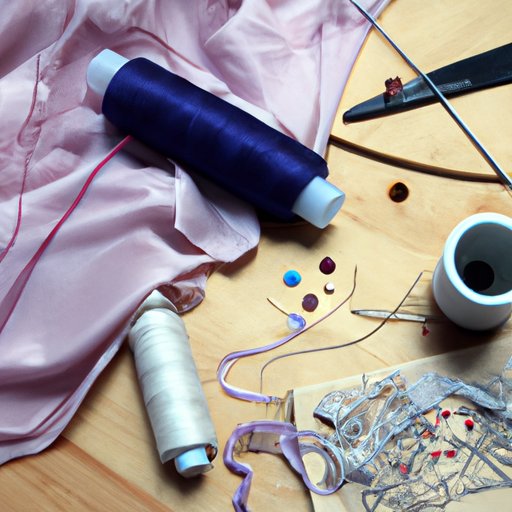
I. Introduction
If you’re interested in learning how to sew, hand sewing is a great place to start. Hand sewing allows you to sew on-the-go, make quick repairs, and add personal touches to your clothing or home decor. In this article, we’ll cover everything you need to know to get started with hand sewing, including beginner tips, essential tools, different types of hand stitches, techniques for reinforcing seams and edges, basic repairs, knot-tying, and creative projects for your home or wardrobe.
II. Tips for Beginners
When you’re first starting out with hand sewing, it’s important to start small. Choose a simple project like mending a small tear or hemming a pair of pants. This will help you get comfortable with holding a needle and thread before you move on to more complex projects.
When choosing materials for your project, make sure you select the appropriate fabric and thread for the job. Choose a thread color that matches your fabric or a contrasting color if you want to create a decorative effect. A good rule of thumb is to use a lightweight thread for lightweight fabrics and a heavier thread for heavier fabrics.
Getting comfortable with holding a needle and thread is an essential part of hand sewing. To get started, hold the needle in your dominant hand and the thread in your non-dominant hand. You can wrap the thread around your fingers to create tension and make it easier to sew.
III. Essential Tools and How to Use Them
There are several basic hand sewing tools that you’ll need to have on hand, including needles, thread, thimbles, scissors, and pins. Needles come in a variety of sizes and styles, so make sure you choose the appropriate needle for your fabric. A thimble is a small metal cap that fits over your finger and helps protect it from the needle as you sew.
To use a needle, simply thread it with your chosen thread and tie a knot at the end. Insert the needle into the fabric and pull the thread through. Repeat until your sewing is complete. Scissors are used for cutting thread and fabric. Make sure you choose a pair of scissors that are sharp and easy to handle.
IV. Different Types of Hand Stitches and When to Use Them
There are several different types of hand stitches that you can use, depending on the type of sewing project you’re working on. The most common stitches include the running stitch, backstitch, and whip stitch.
The running stitch is a basic stitch that is used to sew two pieces of fabric together. To do a running stitch, push the needle in and out of the fabric in a straight line. The backstitch is a stronger stitch that is used for seams that need extra reinforcement. To do a backstitch, push the needle through the fabric and then back through, creating a small backstitch. The whip stitch is used for finishing edges and creating decorative borders. To do a whip stitch, weave the needle in and out of the fabric in a circular motion.
V. Reinforcing Seams and Edges
To reinforce seams and edges, you can use techniques like a backstitch or zigzag stitch. A backstitch is a stronger seam because it creates two parallel lines of stitches. You can also use pinking shears to prevent fraying along the edges of your fabric. If your thread breaks while you’re sewing, simply tie a knot at the end of your thread and start again.
VI. Basic Repairs You Can Do
There are several common clothing repairs that you can do using hand sewing, including fixing buttons, hems, and tears. To fix a missing button, thread your needle and knot the end of your thread. Starting from the back of the fabric, sew the button in place using a backstitch. To fix a tear in your clothing, pin the fabric together and use a whip stitch to sew the two pieces together.
VII. Importance of Knots and How to Tie Them
Knots are an important part of hand sewing because they help keep your thread in place. The most common knot used in hand sewing is the basic knot. To tie a basic knot, simply loop your thread around your needle and pull tight. You can also use a double knot for added security. To tie a double knot, loop your thread around the needle twice and pull tight.
VIII. Creative Projects for Your Home or Wardrobe
If you’re looking for inspiration for your next hand sewing project, there are plenty of options. Some beginner-level projects include making pillowcases, tote bags, or fabric napkins. You can find DIY patterns and inspiration online, or come up with your own designs. Hand sewing is a great way to add a personal touch to your home or wardrobe.
IX. Conclusion
Hand sewing is a versatile skill that can come in handy for everything from mending clothing to creating personalized home decor. By following the tips and techniques in this article, you’ll be well on your way to becoming a skilled hand sewer. Remember to start small, choose the right materials, and practice your stitches and knots. With a little bit of patience and perseverance, you’ll be creating beautiful hand-sewn pieces in no time.





